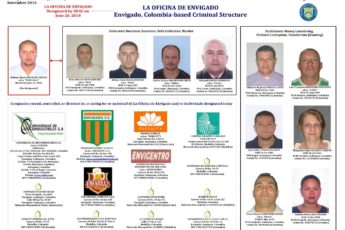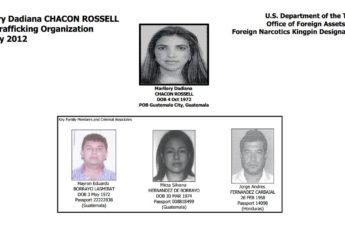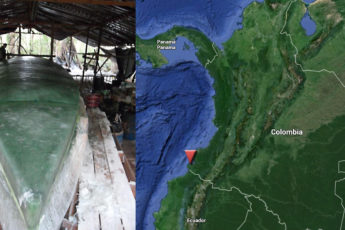The British frigate HMS Argyll recently offloaded 1,056 kilograms of cocaine it seized during two interdictions in November in the Caribbean Sea in support of Operation MARTILLO. The British frigate HMS Argyll recently offloaded 1,056 kilograms of cocaine it seized during two interdictions in November in the Caribbean Sea in [ … ]
Transnational Threats
Alleged Colombian Narco-trafficker Richard Mosquera Mosquera Pleads Guilty
Colombian narco-trafficker Richard Mosquera Mosquera, who is known as “Pipe,” faces a maximum sentence of life in prison after he pleaded guilty in U.S. federal court on November 25 to conspiring to traffic and distribute at least five kilograms of cocain Colombian narco-trafficker Richard Mosquera Mosquera, who is known as [ … ]
Salvadoran Judge Sentences Drug Trafficker ‘Repollo’ to 77 Years in Prison
Salvadoran drug trafficker Jorge Ernesto Ulloa Sibrian allegedly trafficked 10 tons of cocaine to the United States and other destinations over a span of seven years. Salvadoran drug trafficker Jorge Ernesto Ulloa Sibrian allegedly trafficked 10 tons of cocaine to the United States and other destinations over a span of [ … ]

Treasury Designates the Financial Core and Support Network of Colombian Criminal Group La Oficina de Envigado
Action Designates 10 Individuals and 14 Entities, Including the Majority Owners of a Professional Soccer Team The U.S. Department of the Treasury today designated 10 Colombian nationals and 14 entities, primarily located in the cities of Envigado and Medellín, Colombia pursuant to the Foreign Narcotics Kingpin Designation Act (Kingpin Act). [ … ]
Sinaloa Cartel’s Alfredo Vásquez-Hernández Sentenced to 22 years in U.S. Prison
A federal judge in the U.S. city of Chicago sentenced Vásquez-Hernández to 22 years in prison for drug trafficking. Alfredo Vásquez-Hernández and Joaquín “El Chapo” Guzmán grew up as childhood friends in Mexico’s Sinaloa state. Both joined the Sinaloa Cartel, and rose through the ranks; El Chapo became the transnational [ … ]
Guatemala: 10 Alleged Members of Mendoza Family Arrested
A team of Guatemala's Army soldiers, police officers, and prosecutors captured Haroldo Mendoza Matta, the Mendoza organized group alleged leader, as well as nine other suspects during simultaneous raids in four departments on November 20. Thanks to the efforts of Guatemalan law enforcement agents, the ruthless reign of the Mendoza [ … ]

Panamá’s Safe Neighborhoods program fights gangs with enforcement and rehabilitation
Panamá President Juan Carlos Varela’s administration is taking aim at gangs with a two-pronged strategy that includes strong law enforcement efforts with rehabilitation initiatives and social integration opportunities for those who wish to reject a life o Panamá President Juan Carlos Varela’s administration is taking aim at gangs with a [ … ]
Peru, Bolivia Navies to Share Intelligence
Peru and Bolivia have signed a joint agreement to bolster their counter-narcotics fight by allowing their naval units to share satellite information to monitor airspace over Lake Titicaca. Bolivian Deputy Minister of Social Defense Felipe Cáceres announced the agreement on November 18. The neighboring countries will also work in cooperation [ … ]

Guatemala’s ‘Queen of the South’ Reportedly Prepared to Testify Against ‘El Gordo’
A Guatemalan socialite and businesswoman who allegedly ran one of the largest drug trafficking and money laundering rings in Central America is in custody in a U.S. prison. A Guatemalan socialite and businesswoman who allegedly ran one of the largest drug trafficking and money laundering rings in Central America is [ … ]
Alleged Colombian Drug Lord Daniel Barrera Pleads Guilty for Second Time in U.S. Federal Court
Colombian drug kingpin Daniel Barrera has now pleaded guilty to two U.S. federal drug trafficking charges, and faces one more indictment. Colombian drug kingpin Daniel Barrera has now pleaded guilty to two U.S. federal drug trafficking charges, and faces one more indictment. Barrera, who is known as “El Loco,” is [ … ]
Bolivia’s FELCN Combats Drug Traffickers in the Amazon Region
Bolivia’s Special Force in the War on Drugs (FELCN) is intensifying security operations –“fighting organizations of organized crime throughout Bolivia’s Amazon,” in the words of FELCN chief Mario Centellas. Bolivia’s Special Force in the War on Drugs (FELCN) is intensifying security operations –“fighting organizations of organized crime throughout Bolivia’s Amazon,” [ … ]

The Colombian Navy Captures an Alleged FARC Semisubmersible
In a joint operation, the Colombian Navy and Air Force recently seized a submersible vessel that terrorists were constructing in the Department of Nariño. In a joint operation, the Colombian Navy and Air Force recently seized a submersible vessel that terrorists were constructing in the Department of Nariño. The semisubmersible, [ … ]






